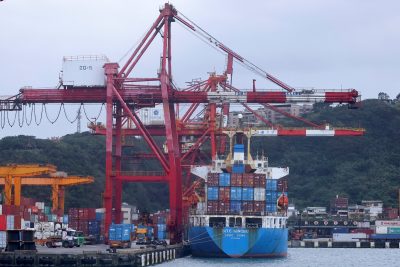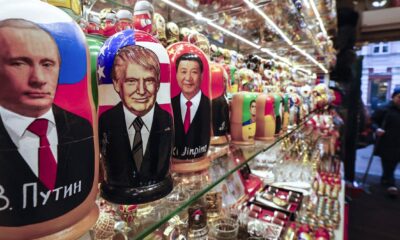Trade
Taiwan’s economy outperforms amid COVID-19 crisis

Author: Min-Hua Chiang, NUS East Asia Institute
Taiwan’s economy has outshined most others in the last two years. While the COVID-19 recession was hard most everywhere else, Taiwan’s economy enjoyed a moderate expansion of 3.1 per cent in 2020 and likely expanded by 6.1 per cent in 2021 — the highest growth recorded since the global financial crisis rebound 12 years ago. Taiwan’s economic expansion is an outlier amid the pandemic.
Vigorous exports explain Taiwan’s outstanding economic performance. Pandemic travel restrictions triggered greater global demand for information and communications technology products. With the gradual return to normal in 2021, Taiwan’s exports of other manufactured products such as metals, plastics, chemicals and textiles all grew significantly. China remained Taiwan’s largest export destination last year, but the growth of exports to the United States (30 per cent), Europe (37 per cent) and Southeast Asian countries (32 per cent) outpaced export growth to China (23 per cent).
Taiwanese firms’ large investment repartition contributed to increasing capital formation. Since 2019, the government incentivized Taiwanese firms with overseas business operations to invest at home. Total investment repartition from 2019 to 2021 was nearly US$37 billion (NT$1,038 billion) — greater than the US$15.9 billion recorded for Taiwan’s outward investment in China during the same period. The semiconductor industry has been the most important contributor to domestic capital formation.
Unlike the thriving manufacturing industry, the service sector grew slowly in 2021. Local accommodation and restaurants were greatly impacted by the imposition of movement restrictions after a domestic outbreak of COVID-19 in May. Despite the partial relaxation of restrictions since the end of July, Taiwan’s local accommodation and food businesses have not fully recovered.
Additional government spending for companies and individuals who suffered through business and jobs losses during the pandemic is another contributor to Taiwan’s economic expansion. Yet compared with most advanced countries, Taiwan’s COVID-19 economic relief budget as a percentage of GDP (4 per cent in 2021) is relatively insignificant thanks to effective COVID containment strategies. Taiwan’s central government debt as a percentage of GDP is low at 30 per cent in 2020. Taiwan has greater capacity to invest in energy and infrastructure, areas of investment that the country is in urgent need of for its growing manufacturing activities.
Yet Taiwan’s participation in regional trade deals is uncertain. Taiwan is less likely to join the Regional Comprehensive Economic Partnership given China’s heavy economic and political weight in the trade pact. Taiwan has more of a chance to be part of the Comprehensive and Progressive Agreement for Trans-Pacific Partnership (CPTPP) thanks to its mature market economy standards. Still, most CPTPP members are small economies and have limited domestic consumption potential. The overall net benefit for Taiwan joining is far from obvious.
A US–Taiwan free trade agreement (FTA) remains far away despite the recent defeat of a Taiwanese referendum that would have blocked pork imports containing ractopamine — a barrier to bilateral trade negotiations with the United States. Domestic initiatives remain the priority for the Joe Biden administration and the United States is inclined towards promoting multilateral economic engagement. Taiwan might hope to join an Indo-Pacific economic framework, but the details and its potential benefits to regional economic growth are far from clear.
Taiwan’s strong economic performance, supported by its manufacturing prowess, showed that the impact of its isolation from regional economic agreements has been limited so far. Bilateral and multilateral FTAs might have more political than economic significance for Taiwan. Taiwan’s greater involvement in regional and global economic agreements would provide an additional layer of economic security in case China sanctions Taiwan’s economy.
Although Taiwan’s investment shift away from China in recent years might help to diversify its exports, it might take a long time to significantly reduce China’s weight in Taiwan’s external trade and accelerate diversification.
Taiwan is likely to continue its export growth momentum while demand from the United States remains strong. Yet the prolonged pandemic crisis around the world suggests that private consumption at home is unlikely to pick up anytime soon….
Trade
Self-Reliance and Openness: Core Principles of China’s Third Plenary Session

The Third Plenum communique from the CCP indicates a prioritization of stability and compromise in response to China’s economic challenges. It highlights the concept of Chinese-style modernization and establishes political guidelines for balancing regulation and market forces.
The CCP’s Third Plenum communique signals a focus on stability and compromise in the face of China’s economic challenges. It emphasises Chinese-style modernisation and sets political directions for balancing regulation and market forces. While not as groundbreaking as previous plenums, it acknowledges the importance of market mechanisms and technological self-reliance, aiming to address issues like high youth unemployment and private sector uncertainty. The communique seeks to navigate the complexities of global competition and domestic innovation, potentially reshaping global supply chains and trade dynamics. Overall, it presents a pragmatic blueprint for China’s economic future.
Source : Self-reliance and openness central pillars of China’s Third Plenum | East Asia Forum
Trade
Trade Prevails Over Political Persuasions in China-Germany Relations

China and Germany maintain a strong bilateral relationship, rooted in economic cooperation despite ideological differences. Recent visits and agreements focus on expanding trade and addressing mutual concerns, navigating challenges while nurturing ties.
Evolving Bilateral Ties
China and Germany share a strong bilateral relationship, rooted in history since 1972. This connection has seen moments of cooperation intertwined with periods of tension. German Chancellor Olaf Scholz’s April 2024 visit underscores Germany’s commitment to fostering this partnership, reflecting a mutual interest in maintaining economic ties despite ideological differences.
Economic Pragmatism
As the second and third largest global economies, China and Germany’s economic interdependence is crucial. Germany emerged as China’s primary trading partner in 2023, with trade values reaching €254.4 billion (US$280 billion). In response to global scrutiny, Germany has taken a balanced approach, emphasizing economic stability over political discord. This was evident during Scholz’s prior visit in November 2022, where his diplomatic tone contrasted with broader EU sentiments.
Facing Challenges Together
Despite increasing public skepticism in Germany regarding China’s global influence and human rights issues, both nations continue to seek common ground. Their October 2023 Joint Statement highlights intentions to pursue cooperation in areas like carbon neutrality and open markets. To navigate these complex terrains, Germany can utilize its institutional frameworks to enhance dialogue, while also considering supply chain diversification to reduce dependency on China. The intertwining nature of their economies suggests that, despite challenges, both countries will continue to prioritize their substantial trade relations.
Source : Trade trumps political persuasions in China–Germany relations
Trade
Fixing fragmentation in the settlement of international trade disputes

Fragmentation in global trade due to the lack of development in multilateral trade rules at the WTO has led to an increase in FTAs. The Appellate Body impasse has further exacerbated fragmentation, requiring a multilateral approach for reform.
Fragmentation in Global Trade
Fragmentation in global trade is not new. With the slow development of multilateral trade rules at the World Trade Organization (WTO), governments have turned to free trade agreements (FTAs). As of 2023, almost 600 bilateral and regional trade agreements have been notified to the WTO, leading to growing fragmentation in trade rules, business activities, and international relations. But until recently, trade dispute settlements have predominantly remained within the WTO.
Challenges with WTO Dispute Settlement
The demise of the Appellate Body increased fragmentation in both the interpretation and enforcement of trade law. A small number of WTO Members created the Multi-Party Interim Appeal Arbitration Arrangement (MPIA) as a temporary solution, but in its current form, it cannot properly address fragmentation. Since its creation in 2020, the MPIA has only attracted 26 parties, and its rulings have not been consistent with previous decisions made by the Appellate Body, rendering WTO case law increasingly fragmented.
The Path Forward for Global Trade
Maintaining the integrity and predictability of the global trading system while reducing fragmentation requires restoring the WTO’s authority. At the 12th WTO Ministerial Conference in 2022, governments agreed to re-establish a functional dispute settlement system by 2024. Reaching a consensus will be difficult, and negotiations will take time. A critical mass-based, open plurilateral approach provides a viable alternative way to reform the appellate mechanism, as WTO Members are committed to reforming the dispute settlement system.
Source : Fixing fragmentation in the settlement of international trade disputes







